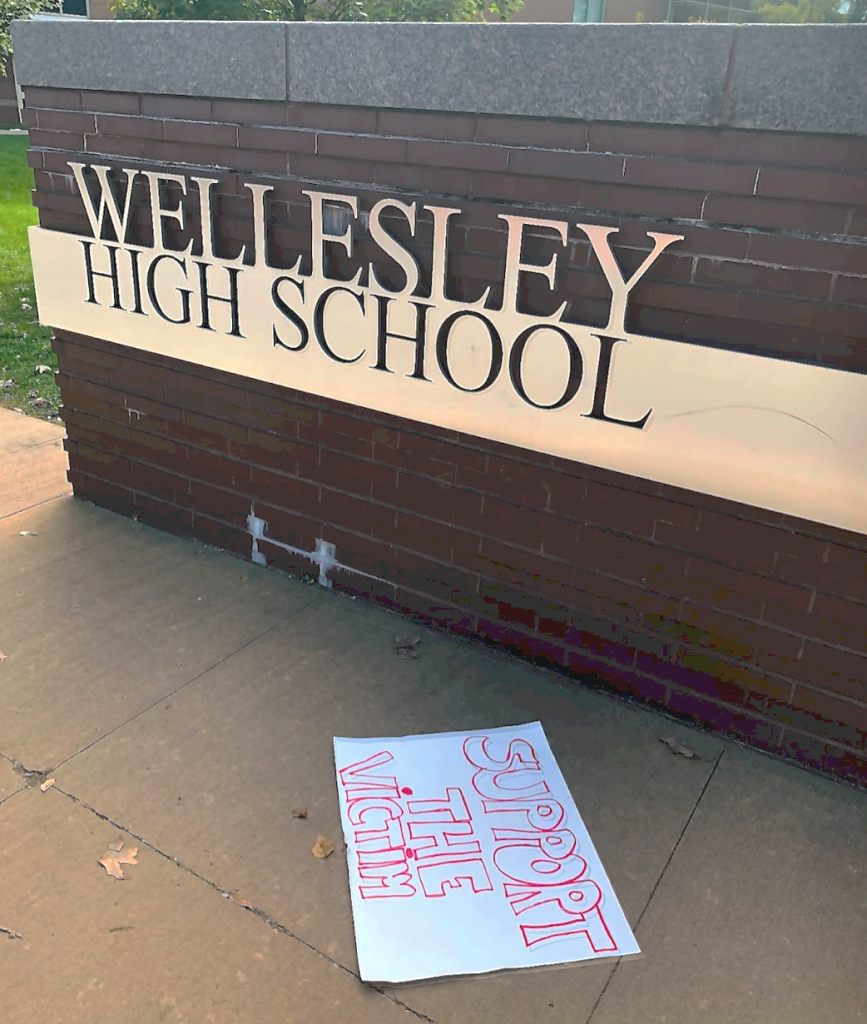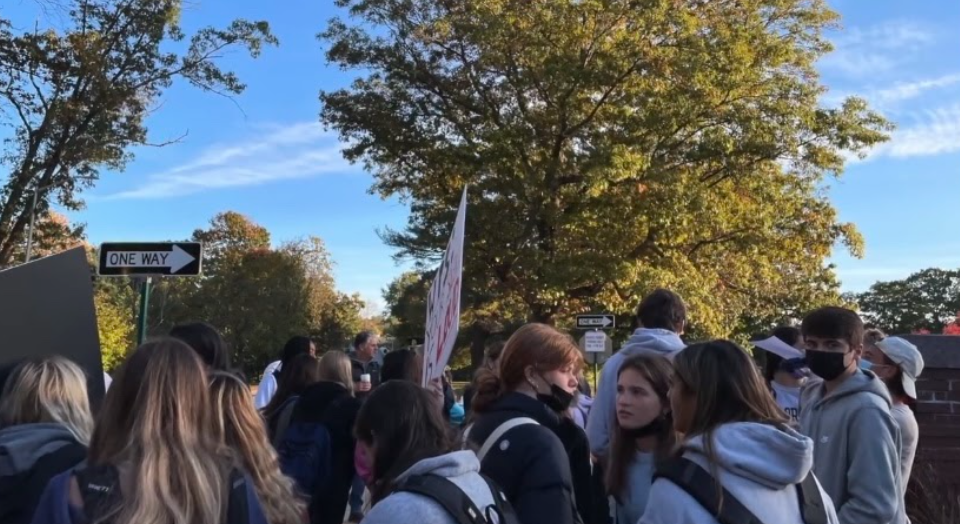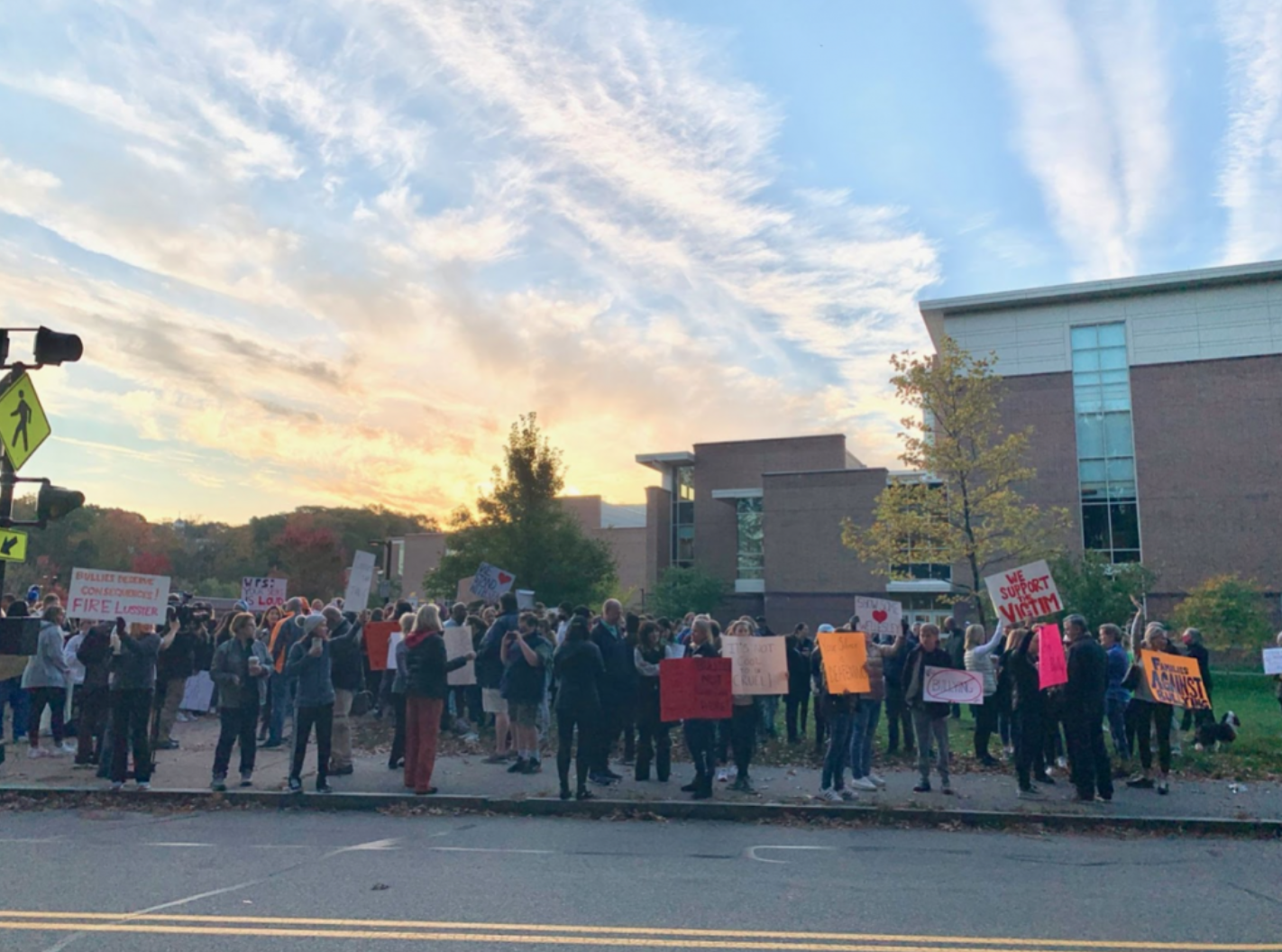Over the summer, a sophomore from the high school was lured into the wood surrounding Bates Elementary School, where he was beaten, spitten on, and urinated on by five other students from the high school.
On the morning of October 20, parents and students gathered outside of the high school to protest the district’s inaction over this institute.
Parents and students held posters and signs with messages such as, “Support the victim. Not the bullies”, “WPS: Your silence is loud”, and “Families against bullies”. News stations were positioned around the peaceful protest, covering the event.
Many felt angry with the district’s response to the bullying and attack that occurred over the summer.
“I think that the administration doesn’t do a good job of addressing any forms of bullying here. These ridiculous, canned responses about how ‘this goes against our core values’, but at this point, I don’t know what the core values are. It’s time for Dr. Lussier to acknowledge that the core values are nothing more than things on paper,” said Christina Horner, a Wellesley resident who attended the protest.
The district administration has been accused of undermining the severity of the bullying incident by not punishing the perpetrators enough. Many parents and students feel that the district has not been making a significant effort to prevent incidents like this from happening in the future.
“They’re trying to push it under the rug, and they said it was just a ‘small mistake’. I wasn’t jumping kids and beating them up and peeing on them and calling it a ‘small mistake’. We all know that’s not a mistake. That’s a pretty bad thing to do,” said Ishan Kundu ’23.
Through the protest, parents hope the school will take more action in creating a safer environment for all students at the high school. They hope that the school administration will step up to address the concerns of parents and students.
“The most important thing is we want children to feel safe coming to school and just being around town. There should be consequences for their actions. What the school didn’t do is an issue and hopefully they’ll change going forward,” said the father of the victim.
However, the protesters want more than justice for the perpetrators of this incident. They hope that their action will also change the way bullying is handled in general by the school administration.
“It’s [bullying] most definitely been happening with other people, they just haven’t spoken out about it because there hasn’t really been a safe place to talk about it before. Now that we’re changing that, it’s going to be easier for people to come out about what they’ve gone through and I’m always open to talking to anybody about it and I will keep it anonymous. I’ll try to help as much as I can,” said the victim in an interview with The Bradford.
At a recent school committee meeting, representatives of the Wellesley public schools, from the elementary schools to the high school, reiterated the responsibilities of the school to protect students from bullying, punish those responsible, and prevent such issues in the future.
David Lussier, the district superintendent, started by emphasizing the importance of maintaining the privacy of students and reiterating the complexities teachers and administrators face when tackling an incident of this magnitude.
“It’s important to know from the outset that we will not be talking about any individual situations. Rather, we will be focusing on what our bullying policy in general looks like in WPS,” said Lussier.
Afterwards, the principals of the different schools talked about their similar approaches to handling and preventing incidents of bullying, with Dr. Jamie Chisum speaking about the high school, Dr. Mark Ito speaking about the middle school, and Mr. Gerardo Martinez of Schofield and Ms. Toni Jolley of Bates speaking about the elementary schools.
In the meeting, many Wellesley residents spoke out in defense of the administration by speaking to the character of the principals at the middle and high school.
“I can confidently, wholeheartedly, and without reservation state that these [Dr. Chisum, Dr. Ito, and Mr. Martinez] are good, smart, and deeply caring people who educate and care for our children with their very best interests in mind” said Joelle Reidy, a parent and school committee member.
Some speakers felt that although the school mishandled elements of the incident, it is more important to move forward together to create a safer, more unified space for their children.
“Perhaps the schools could have handled aspects of these incidents differently, but let us recognize that we are still in the midst of a pandemic. Let us recognize that schools across our state and across the country are embroiled in these hard conversations about the very same errors that we are struggling with here in Wellesley,” said Reidy. “The constant stream of vitriol and hate that is pulsing through our community must end… We must move collaboratively in the spirit of improvement. These are certainly challenging times, but we must figure out how to start having dialogues that are constructive and move in a direction of unity.”
Clementine Zei ’24 Special Projects News Editor, Caroline Thornton ’23 Co-Sports Editor, Adam Juma ’23 Business Manager, Hank Guo ’23 News Editor
How a bullying incident moved the Wellesley community towards change

On July 19, 2021, a WHS sophomore was lured into the woods outside of Bates Elementary School. He was kicked, punched, spit on, and urinated on by five boys who he considered to be his friends.
Many Wellesley residents heard about the incident during the summer, while others became aware of it in October when Dr. Chisum and Dr. Lussier sent an email acknowledging the severity of the assault.
Sophomore, Anna Collomb admitted that she became aware of the incident long before the school publicly acknowledged it.
“I first heard about the incident over the summer from my friends,” said Collomb.
Similarly, Paris Fotiadis ‘23 stated that he heard about the incident months prior to the school’s official recognition of the incident.
“I first heard about the incident in the summer, and I was very surprised that the school wasn’t doing anything about it,” said Fotiadis.
During the months after the assault, parents, students, and other Wellesley residents became concerned with how the school system was addressing the incident and other bullying problems in the district. Community members wondered whether a thirty-day suspension was an appropriate punishment for the perpetrators— to the victim’s family and other Wellesley parents, the suspensions were far too short.
Concern for the victim and frustration with the school’s response sparked an uproar in the Wellesley community; many took to the Facebook group “What’s Up Wellesley” to express their outrage.
“While we have great schools from an educational perspective, it seems we are failing when it comes to a moral compass,” said a Wellesley parent.
Diego Contreras, a new guidance counselor from the Phillips House, believes that the administration could have done things differently, but is unsure about what that would look like.
“It’s hard to say, I don’t know much about what’s happened, so it’s hard for me to have an opinion on how we handled it, but I know people are upset. There’s definitely room for improvement,” said Contreras.
Many parents and students alike have been advocating for improvement in the bullying policies at Wellesley. Wellesley Public School’s twelve-page bullying policy consists of nine conditions that address prevention methods, intervention plans, and consequences, yet many are still unsure of its efficacy. Some community members believe that the policy is well written, but the administration lacks follow-through.
Bullying has always been present in school and outside communities but lacks coverage. As a result, bullying often goes unreported. Theo Braatz ‘22 and Aiden Coleman ‘22, both share how little bullying they see from their experiences.
“From my perspective, not very much bullying takes place at the high school,” said Braatz.
“From my perspective, not an excessive amount but I am aware of a smaller incidence, not as big as this last one,” said Coleman.
Over the last few years, there have been growing concerns about the presence of cyberbullying within Wellesley. Some students feel that the administration focuses too much on this growing problem rather than the in-person incidents between students.
“Bullying can come to many different people as many different types of things. And you can’t just focus on one, or else you could be missing a variety of other types of bullying that are just as serious,” Fotiadis said.
However, during the past year of quarantine, it is likely that cyberbullying increased. With teenagers stuck at home with no outlet to talk to their friends, social media platforms, like Instagram, Snapchat, and TikTok, skyrocketed.
Ms. Devon Ellis, a German teacher at the high school, believes that a lack of physical and social interaction between students results in more bullying and tension.
“In this particular year after Covid and eighteen months of isolation it’s [bullying] probably worse,” said Ellis.
The incident in July, is an example of a larger issue, not only in our school but across the globe. With effective discipline, healing for the victim, and honesty with the community, school administrations can work to create safe, and welcoming environments for all students.
“I think that it is part of a larger issue. I think that although we’ve talked about online harassment especially in the last few years, it has gone up exponentially. I think that we as a society, especially with the pandemic and things being politicized, are becoming fractured. It’s part of a larger issue and I think this is just a manifestation of everything that’s been happening in our world,” said Contreras.
Addie Schiller ‘22 Features Editor, Annabelle Nolan ‘23 Assistant Features Editor, Maddie Merowitz ‘23 Assistant Arts Editor, Fiona Zhou ‘24 Staff Writer
Wellesley school administration needs to do more in response to recent bullying incident

According to a 2017 report by the Department of Education, one out of five American students reports being bullied, with nearly half of them anticipating that it would happen again. Unfortunately, bullying has long been a significant issue within education systems, and Wellesley is no exception.
On July 19th, 2021, a Wellesley High School student was viciously assaulted by fellow students. The victim, a rising sophomore, was lured into the woods and beaten next to his former elementary school. He was kicked, punched, smashed into the ground, and urinated on during the attack. The victim suffered serious lacerations and bruises as well as lasting emotional scars from the attack. The police were promptly informed and took action against the offenders.
Wellesley Public Schools has attempted to follow its twelve-page bullying policy when punishing the students involved. The victim’s parents, as well as some others in the community, feel that the school administration did not appropriately respond to the incident or create a safe space for the victim.
Although the school has taken many meaningful steps thus far, the administration’s response has been in some ways inadequate and has failed the victim of the attack.
Major criticisms of the administration’s response lie in their lenient punishments for the perpetrators and their poor communication of this issue with the community. However, as Dr. Jamie Chisum, principal of the high school, explained, state law does not give the school administration the authority to expel the perpetrators in this situation and discourages him from giving lengthy punishments.
“There is a regulation in Massachusetts in [General Law Chapter 71] that tells us that we are not to resort to punishment first. We are to look at other forms of behavioral changes before we use suspension, ” said Chisum. In addition, laws restrict the school administration from publicly talking about the situation in specific detail, regardless of the substantial attention it has received in the media.
Community members have also expressed anger in the way the school has addressed information in their emails. In the administration’s first email in response to the incident, Chisum and Dr. David Lussier, superintendent of Wellesley Public Schools, used the phrase “Young people make mistakes,” leading many members of the community to consider this an attempt to minimize the situation.
The administration insists its use of the word “mistake” was only an attempt to stress the importance of giving second chances, not an attempt to minimize the victim and cushion the actions of the perpetrators. In these cases, the administration has a solid legal and logical rationale behind its position.
On page 6 of the WPS bullying policy, under Section V Subsection A “Specific Bullying Prevention Approaches,” it states: “Engaging students in a safe, supportive school environment that is respectful of diversity and difference.”
This policy states that students should feel comfortable in their learning environment, but the administration’s lack of response has created an unstable dynamic within the school. By neglecting to deal with this in-school conflict, the school has forsaken these core values and is violating its own policy.
Creating an unsafe environment for the victim, in turn, has also created an unsafe environment for the entire Wellesley community.
“I think that the administration doesn’t do a good job of addressing any forms of bullying. These ridiculous canned responses about how this goes against our core values, but at this point, I don’t know what the core values are. It’s time for Dr. Lussier to acknowledge that the core values are nothing more than things on paper,” said Ms. Christina Horner, a parent of several high school students.
Looking past substantive action, the school failed to even notify the community of the situation until the family of the victim began to apply pressure. The incident, which the school was notified of in August, was not brought to attention until October, after the victim’s family began reaching out to local news outlets. Of course, specific details of the event and the personal details of those involved should not be disclosed, but the school has a duty to inform the student body that an incident occured. At the very least, the school should address bullying as a whole, without having to mention this specific event at all.
The father of the victim notes how the high school can learn from its lackluster response, in order to better confront similar incidents that could occur in the future.
“The most important thing is we want children to feel safe coming to school and being around town. There should be consequences for their actions, and what the school didn’t do is an issue. Hopefully they’ll change going forward,” said the father of the victim.
We agree with this statement. The school’s lackluster response to this situation has failed both the victim and the community, and it must take both responsive and preventive measures to address and prevent bullying as a whole.
Possible solutions to this problem lie in ingrained programs in the school system. According to the Public Access to Court Electronic Records, school-based bullying prevention programs decrease bullying by up to 25 percent. Moving past this situation to the future, the school must do better.
Iris Xia ’22 Co-Opinions Editor, William Liu ’24 Co-Opinions Editor, Tate Bannish ’24 Staff Writer, Griffin Jordan ’24 Staff Writer, John Battaglino ’24 Staff Writer

